| Author |
Message |
    
richarddurgee
Senior Member
Username: richarddurgee
Post Number: 2292
Registered: 11-2001
| | Posted on Wednesday, January 20, 2010 - 09:53 am: | 




|
*
1925
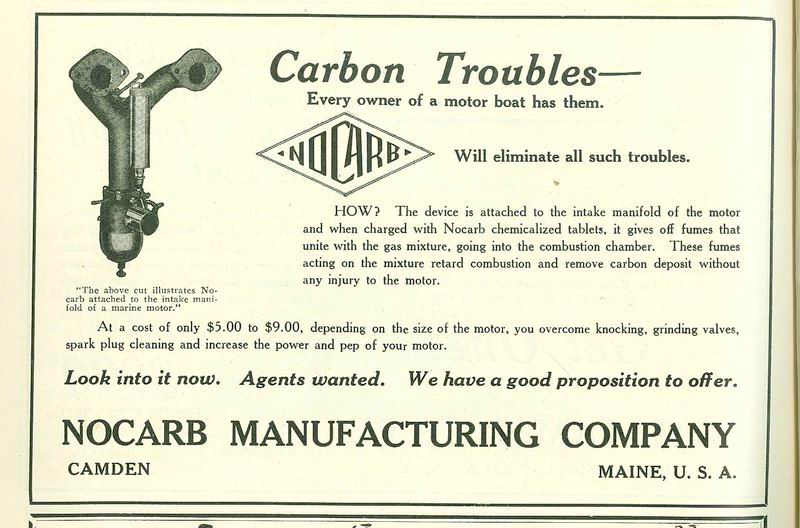
** |
    
searcher
Senior Member
Username: searcher
Post Number: 406
Registered: 10-2004
| | Posted on Wednesday, January 20, 2010 - 11:37 am: | 




|
Richard, in what magazine and month did this ad appear? |
    
richarddurgee
Senior Member
Username: richarddurgee
Post Number: 2293
Registered: 11-2001
| | Posted on Wednesday, January 20, 2010 - 12:06 pm: | 




|
*
Motor Boat April 10,1925
When I saw this I thought if one of these ever shows up on an engine we would scratch our heads trying to figure out what it was ??
If you would like a high res copy emailed - Glad to do it !
** |
    
richarddurgee
Senior Member
Username: richarddurgee
Post Number: 2295
Registered: 11-2001
| | Posted on Wednesday, January 20, 2010 - 01:27 pm: | 




|
*
Same Issue in the What's New in The Trade section
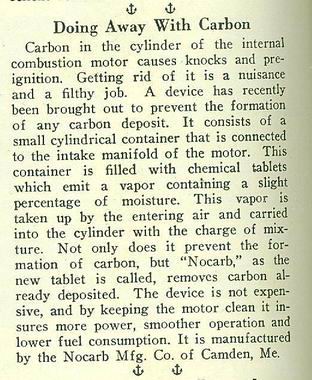
Included this ad as it was news to me that ground glass was used for grinding valve seats, Thought that some sort of emory was the compound even back in days of steam ??
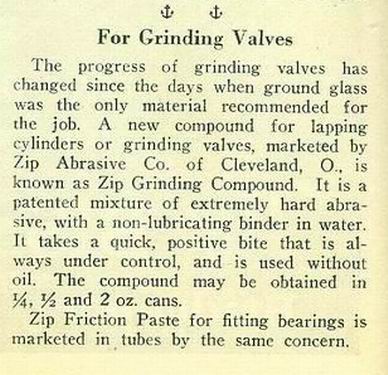
** |
    
searcher
Senior Member
Username: searcher
Post Number: 407
Registered: 10-2004
| | Posted on Wednesday, January 20, 2010 - 09:22 pm: | 




|
Richard, I would like very much to have a high resolution copy of the NOCARB ad. I don't have time to review my file at the moment but I think I may be able to provide some background to this ad. |
    
searcher
Senior Member
Username: searcher
Post Number: 411
Registered: 10-2004
| | Posted on Saturday, February 06, 2010 - 10:02 pm: | 




|
Note that the patent for the NOCARB device was assigned to John Bird. Bird was one of the incorporators (1901)of Camden Anchor-Rockland Machine Co. He served as director and manager of the CA-RM works. CA-RM built the Knox marine engine first in Rockland and later in Camden, Maine. It appears that the first Rockland Machine Co. engines may have been produced c.1899/1900 and may not have had the Knox name on them. The Knox name does appear on the engines built in 1901 and thereafter.
The manifold depicted in the NOCARB ad is from the c.1920 Knox Model G four cycle marine engine. A throttle handle can be seen in the 'y' of the manifold. The carburetor on the end of the manifold is the Knox Model F. With minor modifications, the Model F could supposedly vaporize gasolene, alcohol, distillate, or kerosene. The throttle handle and Model F carburetor in the photo are probably as close as I will ever get to owning a Model G engine.
I have yet to discover what the NOCARB 'chemical element' actually was. I also do not yet know whether Bird assigned the NOCARB patent to CA-RM or sold the device independently. Ah, so much research left to do and so little time left to do it.
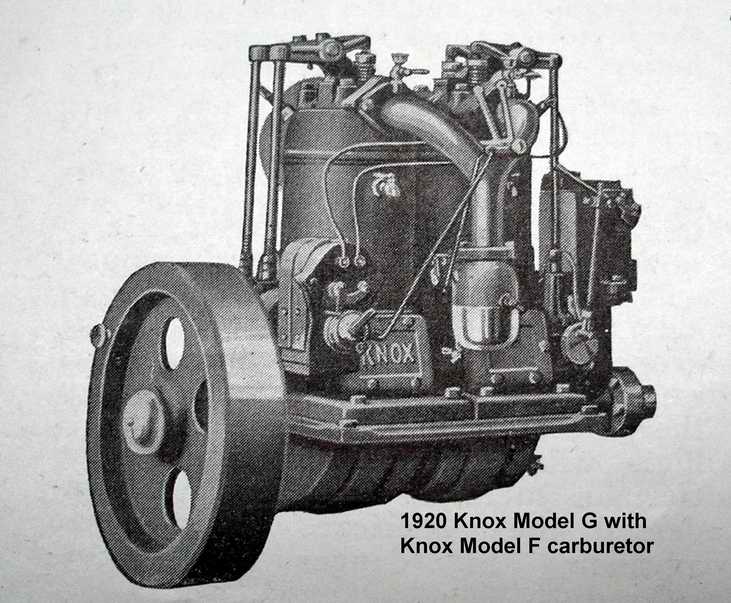
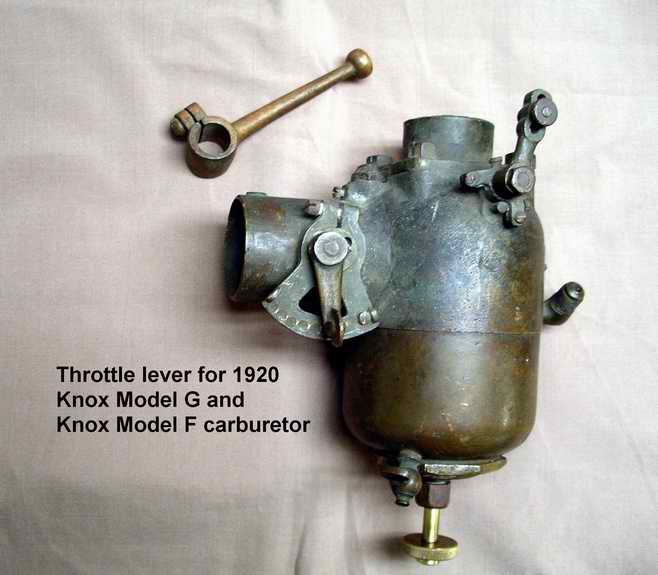
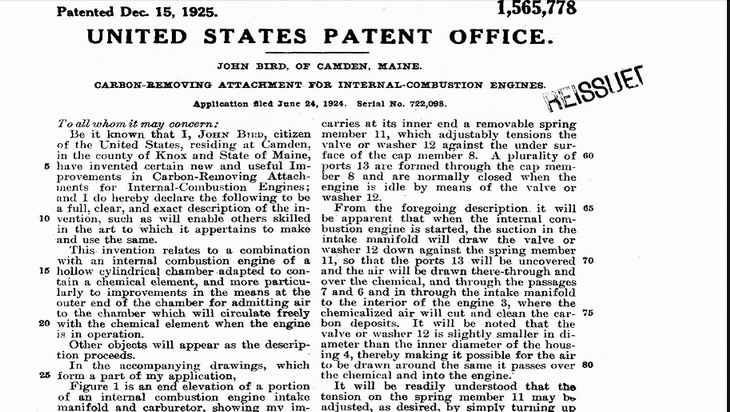
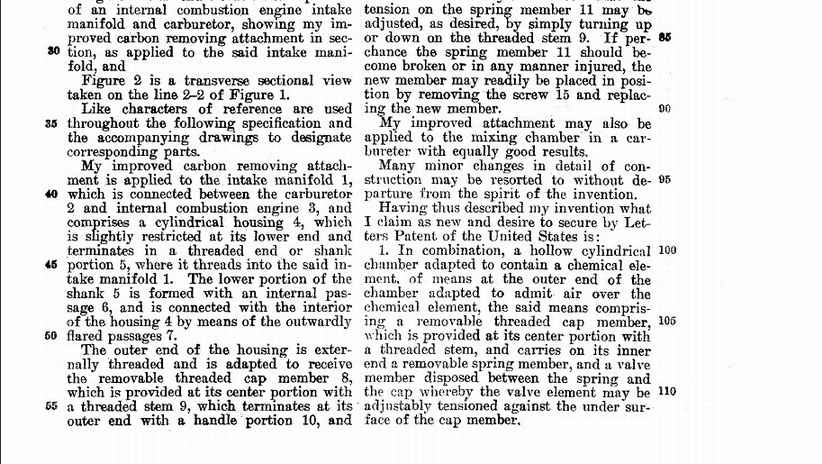
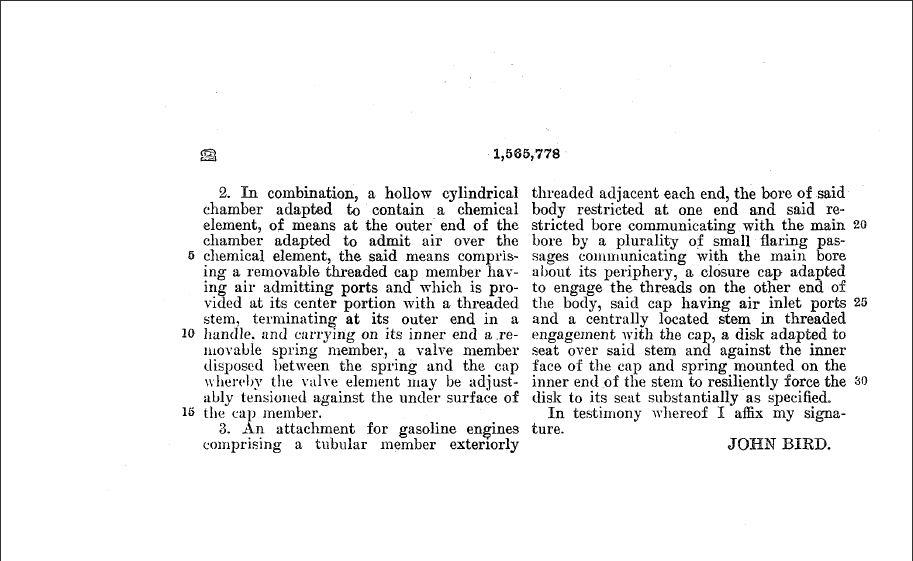
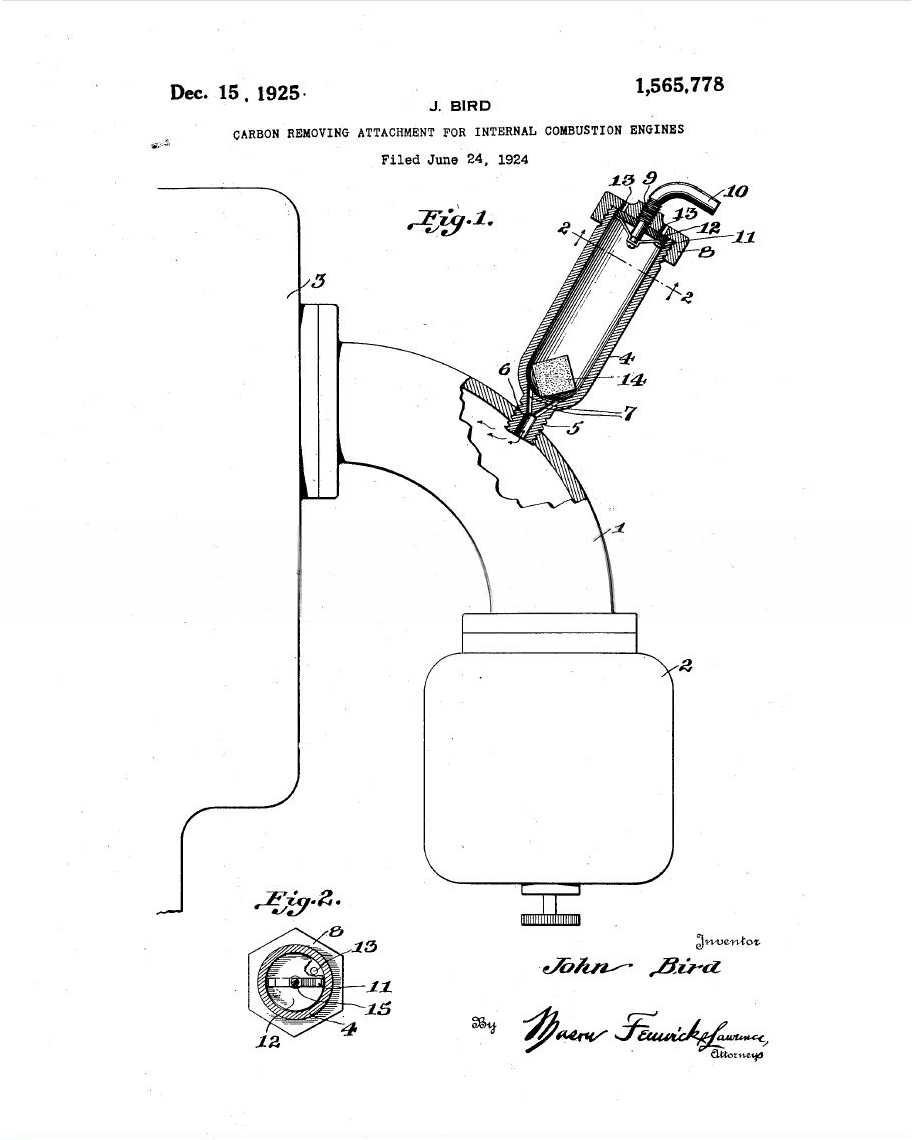 |
    
kerrigan
Advanced Member
Username: kerrigan
Post Number: 36
Registered: 06-2008

| | Posted on Sunday, February 07, 2010 - 09:42 am: | 




|
Gas rationing during WWII created a market for many automobile engine gimmicks. Putting moth balls in the filter bowls of the fuel system was touted as a method to improve performance. I don't recall any claims about moth balls removing carbon. Maybe the mysterious "chemical Element" used in the NOCARB was moth balls. They were cheap and readily available. |
    
searcher
Senior Member
Username: searcher
Post Number: 412
Registered: 10-2004
| | Posted on Sunday, February 07, 2010 - 03:20 pm: | 




|
That was my thought too when I first saw the patent for this device some six years. If not moth balls, it was likely something else just as readily available. |
    
searcher
Senior Member
Username: searcher
Post Number: 413
Registered: 10-2004
| | Posted on Tuesday, February 09, 2010 - 09:30 pm: | 




|
Here is another product sold to address the carbon problem (Power Boating, August 1909).
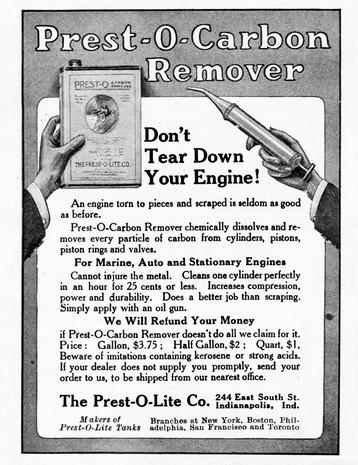 |
    
richardday
Senior Member
Username: richardday
Post Number: 847
Registered: 11-2003

| | Posted on Wednesday, February 10, 2010 - 08:20 pm: | 




|
Back in 1940 I bought a 1921 Model T Ford for $2.00 which I still have in much better condition than it was then I might add. I was working in a drugstore after school for 25 cents an hour. Gasoline was 18 cents/gallon and kerosene was 7 cents/gallon.
In the back of the drugstore we had a large barrel of mothballs which people would come in and buy a quart for 25 cents. Mothballs in those days was parafin soaked in naptha. Ice cream was sold in bulk and if you wanted a quart of ice cream I would fill a quart paper container. The boss was very careful to watch one filling the container because he believe ice cream was very compresible so don't pack it in too tightly. When he would take off home for his evening meal I would fill a quart container of moth balls and run out and dump it in the T gas tank. When I would get off work I would go to the cheapest gas station in town and buy two gallons of gasoline and 3 gallons of kerosene. The T ran fine and started quite normally. Don't know if the mothballs really gave me high test gas but it was common knowledge that mothballs would help!!! |
    
searcher
Senior Member
Username: searcher
Post Number: 415
Registered: 10-2004
| | Posted on Wednesday, February 10, 2010 - 08:31 pm: | 




|
Neat story. Thanks for sharing it. |
    
richarddurgee
Senior Member
Username: richarddurgee
Post Number: 2332
Registered: 11-2001
| | Posted on Wednesday, February 10, 2010 - 10:10 pm: | 




|
*
Dick, That is a good recollection!
In the late 1940's early 50's I pumped gas in my dads station every day after school and weekends, there were many of the pre war cars around and it was common for people to ask me to open the trunk and get the moth balls,seems that each driver had their own mixture. No one ever said filler-up in those days, gas was still around .20 a gallon and one or two dollars worth was a common request, depending on the gallons I'd be asked to put so many moth balls in the tank, the truck guys just dumped some in. many people also added alcohol to their gas at the same time. I asked my dad about it and he said that a little alcohol probably helped break down the water globules and burn it through the engine, the motth balls he didn't think helped the old low compression engines much but when I opened the gas caps did I ever see any moths fly out ? one of my still vivid memories was when I had to get a spare tire out of a trunk that had moth balls stored there , It was powerful stuff my eyes watered and I could hardly breath, I never noticed any moths in those trunks either ! In the late 1950's and early 60's when the really high compression engines became popular There seemed a trend to use regular gas with moth balls once again and many swore that it raised the octane level and was less expensive
than High test. I never tried it, as a youngster I had smelled all the moth balls I would ever care to and still avoid them to this day !
* |
    
searcher
Senior Member
Username: searcher
Post Number: 417
Registered: 10-2004
| | Posted on Wednesday, February 10, 2010 - 11:48 pm: | 




|
Richard, I'm glad you started this thread. Other than a guess that something like mothballs might have been the 'chemical agent' used in the carbon cleaning device in the Knox engine, I was not aware of the obviously wide spread use of mothballs as a fuel additive. Fascinating. I will have to ask my father what he remembers about that use. |
    
richarddurgee
Senior Member
Username: richarddurgee
Post Number: 2333
Registered: 11-2001
| | Posted on Thursday, February 11, 2010 - 10:29 am: | 




|
*
Searcher, After rereading my post above I may have left the impression that using the moth balls was very common in those yrs, actually when I Have given it more thought there was probably less than a handfull of people that I knew of and they were locals and I saw the same few over and over. Was a hold over of people trying to survive through the depression and gas rationing during the war yrs ! Diesel now at $3.00 a gallon I wonder if moth balls could improve the mileage on my truck ??
* |
    
ernie
Senior Member
Username: ernie
Post Number: 1163
Registered: 01-2002

| | Posted on Thursday, February 11, 2010 - 11:56 am: | 




|
The best carbon remover is plain old water H2o
Back in the 70s during the oil company induced gas shortage gas was stored in any availble tank by the oil companies to include gas stations that were closed.
This resulted in real poor gas quality when it was pumped back into the tanker and sold to the retailer.
The resulting problems of spark knock dieseling (run on) when the key was shut off and just poor performance was rampant.
We would have engines apart and the amount of carbon in the compustion chamber and on the piston top was incredible.
We found out that holding the throttle at about 1500 RPM and dribbling in a soda bottle of water (very carefully I might add) removed all the carbon. This was confirmed on several teardowns after the water treatment. The piston top and combustion chamber wood be perfectly clean.
This worked because the water turned to steam and also the extra oxygen molecule in water over air. Also hydrogen burns pretty clean! |
    
richarddurgee
Senior Member
Username: richarddurgee
Post Number: 2341
Registered: 11-2001
| | Posted on Wednesday, February 24, 2010 - 12:36 pm: | 




|
*
Volz Carbon Removal device 1914
http://www.google.com/patents?id=EkteAAAAEBAJ&pg=PA1&dq=gas+engine+carbon+remove r+1914&source=gbs_selected_pages&cad=1#v=onepage&q=gas%20engine%20carbon%20remov er%201914&f=false
* |


